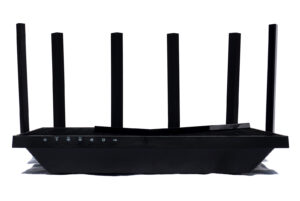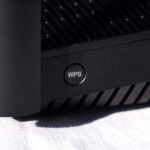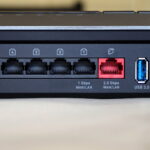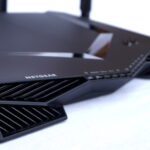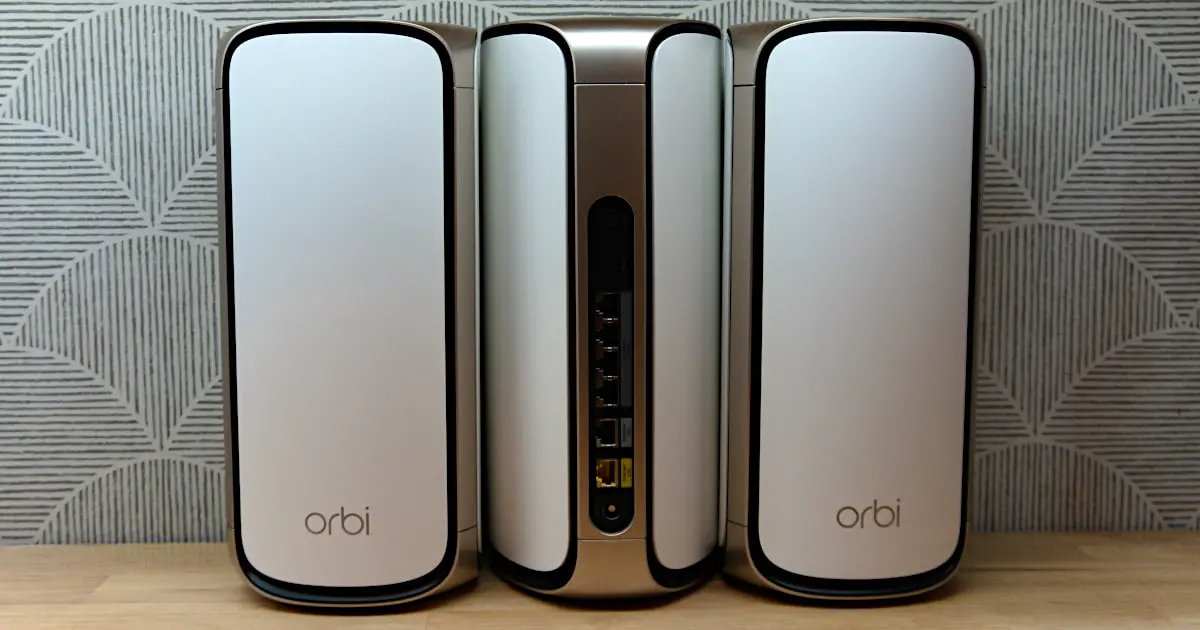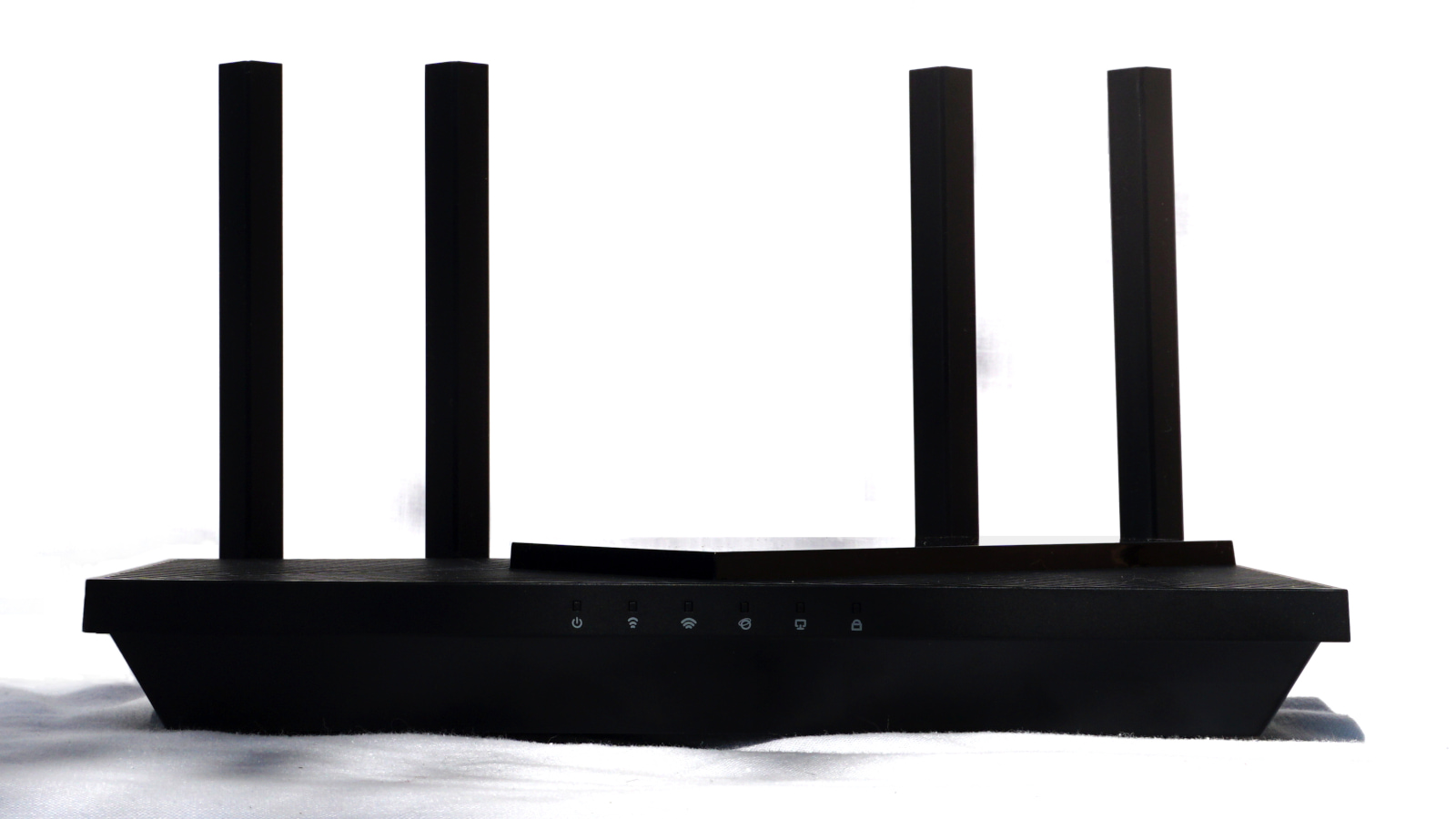Best Wi-Fi 6E Routers of 2024
We tested a batch of Wi-Fi 6E routers to see if they're worth the upgrade from Wi-Fi 5 and Wi-Fi 6.
Jul 19, 2024 | Share
Equipment Guides, Product Reviews
-
Best overallLinksys Hydra Pro 6E
- $179.99
- 5Gbps internet support
- Mesh support
- Barebones design
-
Best for priceTP-Link Archer AXE75
- $179.99*
- VPN tools
- Basic parental controls
- No multi-gig ports
-
Best for gamersMSI RadiX GRAXE66
- $160.99*
- Antenna illumination
- BitTorrent client
- No real gaming tools
-
Best for rangeNETGEAR Nighthawk RAXE500
- $492.42*
- Long range
- Media sharing
- High price
-
Best for meshTP-Link Deco XE75 Pro
- $139.99*†
- IoT networking
- Device isolation
- Subscription-locked features
* Amazon.com prices (as of 7/19/24 14:45 MST). Read full disclaimer.
† Price for one (1) unit only.
Our pick: Which Wi-Fi 6E router is best?
The Linksys Hydra Pro 6E takes our spot as the best Wi-Fi 6E router we’ve tested to date. Sure, it’s a bare-bones router compared to others on our list, but it offers great speeds and 5Gbps internet support at a decent price. If you want a router specific to gaming, the MSI RadiX GRAXE66 is a better fit. Want the longest range you can get? The NETGEAR Nighthawk RAXE500 has the Hydra Pro 6E beat based on our 5 GHz tests.
How we test routers
We vigorously test routers to see how well they stack up against the competition in speed and range. We also evaluate the setup process and dig into the web and mobile apps to see if they’re easy or difficult to use. Check out our methodology section for more information.
The 5 best Wi-Fi 6E routers
- Best overall: Linksys Hydra Pro 6E
- Best for price: TP-Link Archer AXE75
- Best for gamers: MSI RadiX GRAXE66
- Best for range: NETGEAR Nighthawk RAXE500
- Best for mesh: TP-Link Deco XE75 Pro
Compare Wi-Fi 6E router speeds and prices
| Model | Max throughput | Tested speed @ 30 ft.† | Price* | Order online | |
|---|---|---|---|---|---|
| Best overall | Linksys Hydra Pro 6E | 6,600Mbps | 1,014Mbps† | $179.99 | View on Amazon |
| Best for budgets | TP-Link Archer AXE75 | 5,400Mbps | 545Mbps† | $179.99 | View on Amazon |
| Best for gamers | MSI RadiX GRAXE66 | 6,600Mbps | 976Mbps† | $160.99 | View on Amazon |
| Best for range | NETGEAR Nighthawk RAXE500 | 11,000Mbps | 1,030Mbps† | $492.42 | View on Amazon |
| Best for mesh | TP-Link Deco XE75 Pro | 5,400Mbps | 413Mbps§ | $139.99‡ | View on Amazon |
* Amazon.com Prices (as of 7/19/24 14:45 MST). Read full disclaimer.
† Speed recorded using a Wi-Fi 6E client, the 6 GHz band, and a 160 MHz channel.
‡ Price for one (1) unit only.
§ Speed recorded using a Wi-Fi 6 client, the 5 GHz band, and an 80 MHz channel.
What should you look for in a Wi-Fi 6E router?
Wi-Fi 6E is a half-step between Wi-Fi 6 and Wi-Fi 7. It adds the 6 GHz Wi-Fi band to deliver faster wireless speeds than the 5 GHz band. But the new connection really shines if the router has a multi-gig internet (WAN) port. Just look at the difference between the Linksys Hydra Pro 6E and the TP-Link Archer AXE75, both listed in our roundup, to see how a multi-gig internet port makes a huge difference in your Wi-Fi speeds.
Do you have a multi-gig plan to go with your Wi-Fi 6E router?
If not, enter your zip code below to see what options are available to you.
Best overall—Linksys Hydra Pro 6E
 |
|
A good bare-bones candidate for 5Gbps internet |
|
Score:3.9out of 5 |
The Hydra Pro 6E has great multi-gig speeds for the money thanks to its 5Gbps internet port and 6 GHz Wi-Fi band. But it lacks some features commonly found on other routers. |
| Pros | Cons |
|
|
$179.99*
* Amazon.com Price (as of 7/19/24 14:45 MST). Read full disclaimer.
Expand for product details and ratings
| Category | Score* | Summary |
| Performance | 4 | Hits high 6 GHz speeds based on our tests. |
| Features | 3 | Lacks many features offered on competing routers. |
| Design | 4 | Includes a 5Gbps WAN port and a third 6 GHz band. |
| Setup | 4 | Requires the Linksys app to get your network running. |
| Ease of use | 4 | Presents a pretty interface but hides some settings by default. |
* out of 5 points
What we like about it: The 5Gbps WAN port and the new 6 GHz band mean you’ll see great real-world multi-gig wireless speeds on your Wi-Fi 6E devices. It also has basic parental controls, file sharing, and mesh networking support.
What we wish it did better: It needs more of the USB-based features seen on comparable routers—like FTP and DLNA support and a built-in VPN server.
Why do we recommend it? If speed is all you need, the Hydra Pro 6E delivers with its 5Gbps WAN port and the new 6 GHz Wi-Fi band. It can handle lots of devices simultaneously, too, making it a great network centerpiece.
Tested speeds at a glance
| 6 GHz max speed | 2 feet | 40 feet | 120 feet |
| 2,400 | 1,590 | 1,014 | 171 |
* Speeds in megabits per second (Mbps) using a Wi-Fi 6 client and a 160 MHz channel.
| Wi-Fi specs | Wired specs |
|
|
Best for price—TP-Link Archer AXE75
|
Kevin Parrish | HighSpeedInternet.com |
|
A decent and affordable upgrade from Wi-Fi 5 |
|
Score:3.8out of 5 |
The Archer AXE75 is a decent pick if you’re upgrading from a Wi-Fi 5 router. It includes a third 6 GHz band, but it doesn’t have the wired speeds to back up the advertised throughput. |
| Pros | Cons |
|
|
$179.99*
* Amazon.com Price (as of 7/19/24 14:45 MST). Read full disclaimer.
Expand for product details and ratings
| Category | Score* | Summary |
| Performance | 4 | Matches the speeds of other 5,400Mbps routers in our tests. |
| Features | 4 | Includes VPN tools, file sharing, and basic parental controls. |
| Design | 3 | Lacks a multi-gig internet port to back the 160 MHz channels. |
| Setup | 3 | Takes longer to set up due to a few unnecessary steps. |
| Ease of use | 4 | Provides a decent user experience in the web interface and Tether app. |
* out of 5 points
What we like about it: The Archer AXE75 has good Wi-Fi 6 speeds based on our tests, with an 854Mbps average at close range and 254Mbps at 120 feet. The built-in VPN server and client are a plus.
What we wish it did better: The router needs a multi-gig internet port to back up the advertised 2,402Mbps throughput on the 5 GHz and 6 GHz Wi-Fi bands.
Why do we recommend it? The Archer AXE75 is a decent upgrade from a Wi-Fi 5 router. It packs VPN tools, file and media sharing, and a third 6 GHz band. It has good Wi-Fi 6 speeds based on our tests, too.
Tested speeds at a glance
| 6 GHz max speed | 2 feet | 40 feet | 120 feet |
| 2,400 | 926 | 150 | N/A |
* Speeds in megabits per second (Mbps) using a Wi-Fi 6 client and a 160 MHz channel.
| Wi-Fi specs | Wired specs |
|
|
Best for gamers—MSI RadiX GRAXE66
 |
|
The best for Windows gamers with MSI products |
|
Score:4.5out of 5 |
The RadiX GRAXE66 is best for Windows gamers with MSI products. There’s a lot to love here for gamers and non-gamers alike, but you may find the previous Wi-Fi 6 model a better deal if you don’t need cool lighting. |
| Pros | Cons |
|
|
$160.99*
* Amazon.com Price (as of 7/19/24 14:45 MST). Read full disclaimer.
Expand for product details and ratings
| Category | Score* | Summary |
| Performance | 5 | Has some of the fastest close-range tested speeds. |
| Features | 4 | Includes a built-in VPN server and BitTorrent client. |
| Design | 5 | Supports multi-gig internet and actual wireless speeds above 1,000Mbps. |
| Setup | 4 | Gets you up and running in no time. |
| Ease of use | 3 | Lacks tools to change the LEDs outside the Windows app. |
* out of 5 points
What we like about it: The RadiX GRAXE66 has some of the best close-range Wi-Fi 6 speeds we’ve tested to date. Other notable wins include multi-gig internet support, customizable lighting, and a built-in BitTorrent client.
What we wish it did better: It lacks lighting controls in the web interface, meaning Linux and Mac gamers can’t customize the colors and effects.
Why do we recommend it? The RadiX GRAXE66 has stellar performance based on our tests, making it a better megabit-per-dollar value than our top speed demon in stock, the NETGEAR Nighthawk RAXE500. The colored lighting is neat if you’re into that sort of thing, plus it can prioritize traffic from other MSI PCs and hardware. There are non-gaming features as well, including basic parental controls and a built-in BitTorrent client.
Tested speeds at a glance
| 6 GHz max speed | 2 feet | 40 feet | 120 feet |
| 2,400 | 1,530 | 390 | 135 |
* Speeds in megabits per second (Mbps) using a Wi-Fi 6 client and a 160 MHz channel.
| Wi-Fi specs | Wired specs |
|
|
Best for range—NETGEAR Nighthawk RAXE500
|
Kevin Parrish | HighSpeedInternet.com |
|
An expensive speedster with an incredible range |
|
Score:4.2out of 5 |
The RAXE500 has some of the fastest speeds we’ve tested to date. Plus, it has an excellent range if you’re in the mood to stream video to your neighbor’s front yard. |
| Pros | Cons |
|
|
$492.42*
* Amazon.com Price (as of 7/19/24 14:45 MST). Read full disclaimer.
Expand for product details and ratings
| Category | Score* | Summary |
| Performance | 5 | Outpaces nearly every gaming and non-gaming router we’ve tested. |
| Features | 3 | Requires subscriptions to use the parental controls and security fully. |
| Design | 4 | Includes a third Wi-Fi band and multi-gig internet support. |
| Setup | 4 | Has one of the fastest setups we’ve endured. |
| Ease of use | 4 | Provides a better experience in the app than the web interface. |
* out of 5 points
What we like about it: The RAXE500 has the best range and some of the fastest speeds we’ve tested, thanks to the new 6 GHz band. It also has an OpenVPN server to hide your actions online and a built-in media server to share your files locally and across the internet.
What we wish it did better: The RAXE500 needs more free parental controls—all you can do is create a profile, assign a device, and pause the internet. It should also have a free built-in VPN client like the competition, versus forcing you to pay for Bitdefender VPN.
Why do we recommend it? You can’t beat the RAXE500 in speed and range. The new 6 GHz connection promises the ultrafast speeds the 5 GHz band doesn’t consistently deliver. Plus, there are a few tidbits thrown in to sweeten the deal. Get it if you’re good with the hefty price.
Tested speeds at a glance
| 5 GHz max speed | 2 feet | 40 feet | 120 feet |
| 2,400 | 1,550 | 396 | 120 |
* Speeds in megabits per second (Mbps) using a Wi-Fi 6 client and an 80 MHz channel.
| Wi-Fi specs | Wired specs |
|
|
Best for mesh—TP-Link Deco XE75 Pro

One of the best mesh systems we’ve tested |
|
Score:4.3out of 5 |
You can’t go wrong with the Deco XE75 Pro. It’s surprisingly loaded with features, but expect to pay for a subscription to get the most out of it. |
| Pros | Cons |
|
|
$139.99*†
* Amazon.com Price (as of 7/19/24 14:45 MST). Read full disclaimer.
† Price for one (1) unit only.
Expand for product details and ratings
| Category | Score* | Summary |
| Performance | 4 | Has some of the best speeds we’ve tested for a mesh system. |
| Features | 5 | Packs VPN tools, IoT networking, and more. |
| Design | 4 | Includes a third 6 GHz Wi-Fi band for Deco-to-Deco communication. |
| Setup | 4 | Gets you up and running quickly. |
| Ease of use | 5 | Makes network management easy through the Deco app. |
* out of 5 points
What we like about it: We recorded good speeds, especially when we tested the communication between the router and the satellite unit. The system also has a few decent features you normally don’t see from a mesh system.
What we wish it did better: We need the ability to manually change the Wi-Fi channels, as the best one picked by the AI may not be ideal in your home or office.
Why do we recommend it? The Deco XE75 has the best speeds we’ve tested to date for a mesh system in part due to the dedicated Deco-to-Deco line. It also packs some cool features for the money, like basic parental controls and built-in VPN tools.
Tested speeds at a glance
| 5 GHz max speed | 2 feet | 40 feet | 120 feet |
| 1,200 | 829 | 413 | 124 |
* Speeds in megabits per second (Mbps) using a Wi-Fi 6 client and an 80 MHz channel.
| Wi-Fi specs | Wired specs |
|
|
Wi-Fi 6E specs and features
So, what do you look for in a Wi-Fi 6E standalone router or mesh system? We list a few callouts to keep in mind.
Multi-gig WAN
The 6 GHz Wi-Fi band enables real-world multi-gig wireless speeds. To get the most out of this new connection, the router needs a multi-gig internet (WAN) port. As we show in our benchmarks, the faster port can make a huge difference
For example, when we test a router’s 160 MHz Wi-Fi channel at close range, we can get an 1,530Mbps average if it has a multi-gig Ethernet port. Slower Gigabit Ethernet ports reduce our speed results to around 926Mbps average. Sure, you can get superfast file transfers between two Wi-Fi 6E devices, but we’re betting you’re gunning for faster Wi-Fi speeds for internet use.
High throughput
The throughput number doesn’t mean a single device will see 11,000Mbps speeds. Instead, it’s the maximum data amount a router can transfer across all bands working at once. The higher a router’s throughput, the more likely it can handle the multitude of devices connected to it in any given second. For example, the Nighthawk router listed above can transfer data to 12 devices every second, whereas the Deco mesh system can only transmit to six devices each second.
Mesh networking
Standalone routers are now really good about blasting the 5 GHz connection throughout a home, but the 6 GHz band has a shorter range, so it has a harder time penetrating walls and objects. Plus, it broadcasts at a lower power, so while you may get superfast speeds at close range, you may get garbage speeds usually where you see good speeds using a 5 GHz connection. If you need whole-home coverage, we suggest getting a router with built-in mesh networking so you can easily add a similar router or Wi-Fi extender. Wi-Fi EasyMesh is becoming the new standard, so watch for that.
Antennas
The number of antennas usually coincides with a router’s maximum throughput and wireless radio count. Each wireless radio needs at least two antennas for MU-MIMO and Beamforming features, which enable simultaneous multi-device transmissions and stronger connections. And based on our tests, we always get more megabits per second at 120 feet from routers with external antennas than those with internal ones.
Our verdict
The Linksys Hydra Pro 6E is our top pick for the best Wi-Fi 6E router we’ve tested to date. While it lacks some standard features we normally get on routers, like built-in VPN tools and media sharing, it makes up for its shortcomings through great Wi-Fi 6E speeds and 5Gbps internet support at a great price. But if you’re looking for gaming-specific features or fast speeds at a superlong range, MSI and NETGEAR have Wi-Fi 6E routers that are a better fit.
Methodology
We test router speed by setting up each router in an office and connecting it to a local test server. Then, we transmit test data between our wireless devices and the server, taking numerous measurements to account for fluctuations in Wi-Fi speeds.
The first tests occur close to the router, without obstructions—so the Wi-Fi is as strong and fast as it’s gonna get. We repeat the process straight out at 10, 20, and 30 feet, with only a glass door obstructing our view of the router. The same glass door and an exterior door blocks our path when we test outside at 40 and 50 feet.
We also run tests in a hallway to the left of the TV room and office—where there’s a glass door, three walls, and an air handler unit blocking our view of the router. The dining room, another testing point, sits to the right of the kitchen, TV room, and office—two walls and a glass door block the path in this test.
To test video streaming, we connect a fast storage device to the router and stream a 4K video to six wireless devices simultaneously—two phones, three tablets, and a laptop—connected to the same wireless band.
Client devices used in testing
| Google Pixel 6 | iPhone 12 Pro Max | Google Pixel 3 | |
|---|---|---|---|
| Wi-Fi version | Wi-Fi 6E | Wi-Fi 6 | Wi-Fi 5 |
| Stream configuration | 2 x 2 | 2 x 2 | 2 x 2 |
| Max channel width | 160MHz | 80MHz | 80MHz |
| Max 6GHz speed (AXE) | 2,400Mbps | – | – |
| Max 5GHz speed (AX) | 2,400Mbps | 1,200Mbps | – |
| Max 5GHz speed (AC) | 866Mbps | 866Mbps | 866Mbps |
| Max 2.4GHz speed (AX) | 195Mbps | 195Mbps | – |
| Max 2.4GHz speed (AC) | 144Mbps | 195Mbps | 144Mbps |
| Max 2.4 GHz speed (N) | 144Mbps | 144Mbps | 144Mbps |
| Wi-Fi version | |
| Google Pixel 6 | Wi-Fi 6E |
| iPhone 12 Pro Max | Wi-Fi 6 |
| Google Pixel 3 | Wi-Fi 5 |
| Stream configuration | |
| Google Pixel 6 | 2 x 2 |
| iPhone 12 Pro Max | 2 x 2 |
| Google Pixel 3 | 2 x 2 |
| Max channel width | |
| Google Pixel 6 | 160MHz |
| iPhone 12 Pro Max | 80MHz |
| Google Pixel 3 | 80MHz |
| Max 6GHz speed (AXE) | |
| Google Pixel 6 | 2,400Mbps |
| iPhone 12 Pro Max | – |
| Google Pixel 3 | – |
| Max 5GHz speed (AX) | |
| Google Pixel 6 | 2,400Mbps |
| iPhone 12 Pro Max | 1,200Mbps |
| Google Pixel 3 | – |
| Max 5GHz speed (AC) | |
| Google Pixel 6 | 866Mbps |
| iPhone 12 Pro Max | 866Mbps |
| Google Pixel 3 | 866Mbps |
| Max 2.4GHz speed (AX) | |
| Google Pixel 6 | 195Mbps |
| iPhone 12 Pro Max | 195Mbps |
| Google Pixel 3 | – |
| Max 2.4GHz speed (AC) | |
| Google Pixel 6 | 144Mbps |
| iPhone 12 Pro Max | 195Mbps |
| Google Pixel 3 | 144Mbps |
| Max 2.4 GHz speed (N) | |
| Google Pixel 6 | 144Mbps |
| iPhone 12 Pro Max | 144Mbps |
| Google Pixel 3 | 144Mbps |
Router benchmarks
Here are the average speeds recorded for each router and system. Wi-Fi speeds fluctuate significantly, so these numbers reflect at least three tests taken at each 10-foot interval.
Linksys Hydra Pro 6E (6 GHz)
| Google Pixel 6 | |
|---|---|
| 2 feet | 1,590 |
| 10 feet | 1,520 |
| 20 feet | 1,436 |
| 30 feet | 1,014 |
| 40 feet (porch) | 679 |
| 120 feet (across street) | 171 |
| 2 feet | |
| Google Pixel 6 | 1,590 |
| 10 feet | |
| Google Pixel 6 | 1,520 |
| 20 feet | |
| Google Pixel 6 | 1,436 |
| 30 feet | |
| Google Pixel 6 | 1,014 |
| 40 feet (porch) | |
| Google Pixel 6 | 679 |
| 120 feet (across street) | |
| Google Pixel 6 | 171 |
* Speeds in megabits per second (Mbps) using an 160 MHz channel.
TP-Link Archer AXE75 (6 GHz)
| Google Pixel 6 | |
|---|---|
| 2 feet | 926 |
| 10 feet | 875 |
| 20 feet | 779 |
| 30 feet | 545 |
| 40 feet (porch) | 150 |
| 120 feet (across street) | No connection |
| 2 feet | |
| Google Pixel 6 | 926 |
| 10 feet | |
| Google Pixel 6 | 875 |
| 20 feet | |
| Google Pixel 6 | 779 |
| 30 feet | |
| Google Pixel 6 | 545 |
| 40 feet (porch) | |
| Google Pixel 6 | 150 |
| 120 feet (across street) | |
| Google Pixel 6 | No connection |
* Speeds in megabits per second (Mbps) using a 160 MHz channel.
MSI RadiX GRAXE66 (6 GHz)
| Google Pixel 6 | |
|---|---|
| 2 feet | 1,530 |
| 10 feet | 1,380 |
| 20 feet | 1,003 |
| 30 feet | 976 |
| 40 feet (porch) | 390 |
| 120 feet (across street) | 135 |
| 2 feet | |
| Google Pixel 6 | 1,530 |
| 10 feet | |
| Google Pixel 6 | 1,380 |
| 20 feet | |
| Google Pixel 6 | 1,003 |
| 30 feet | |
| Google Pixel 6 | 976 |
| 40 feet (porch) | |
| Google Pixel 6 | 390 |
| 120 feet (across street) | |
| Google Pixel 6 | 135 |
* Speeds in megabits per second (Mbps) using an 160 MHz channel.
NETGEAR Nighthawk RAXE500 (6 GHz)
| Google Pixel 6 | |
|---|---|
| 2 feet | 1,550 |
| 10 feet | 1,325 |
| 20 feet | 1,180 |
| 30 feet | 1,030 |
| 40 feet (porch) | 396 |
| 120 feet (across street) | 120 |
| 2 feet | |
| Google Pixel 6 | 1,550 |
| 10 feet | |
| Google Pixel 6 | 1,325 |
| 20 feet | |
| Google Pixel 6 | 1,180 |
| 30 feet | |
| Google Pixel 6 | 1,030 |
| 40 feet (porch) | |
| Google Pixel 6 | 396 |
| 120 feet (across street) | |
| Google Pixel 6 | 120 |
* Speeds in megabits per second (Mbps) using a 160 MHz channel.
TP-Link Deco XE75 Pro (5 GHz)
| iPhone 12 Pro Max | Google Pixel 3 | |
|---|---|---|
| 2 feet | 829 | 621 |
| 10 feet | 767 | 570 |
| 20 feet | 634 | 509 |
| 30 feet | 595 | 419 |
| 40 feet (porch) | 413 | 254 |
| 120 feet (across street) | 124 | 93 |
| 2 feet | |
| iPhone 12 Pro Max | 829 |
| Google Pixel 3 | 621 |
| 10 feet | |
| iPhone 12 Pro Max | 767 |
| Google Pixel 3 | 570 |
| 20 feet | |
| iPhone 12 Pro Max | 634 |
| Google Pixel 3 | 509 |
| 30 feet | |
| iPhone 12 Pro Max | 595 |
| Google Pixel 3 | 419 |
| 40 feet (porch) | |
| iPhone 12 Pro Max | 413 |
| Google Pixel 3 | 254 |
| 120 feet (across street) | |
| iPhone 12 Pro Max | 124 |
| Google Pixel 3 | 93 |
* Speeds in megabits per second (Mbps) using an 80 MHz channel.
FAQ about Wi-Fi 6E routers
Why didn't you test the 6 GHz speeds on the Deco XE75 Pro?
Wi-Fi 6 vs. Wi-Fi 6E: What's the difference?
Disclaimer
Amazon.com Prices as of 7/19/24 14:45 MST. Product prices and availability are accurate as of the date/time indicated and are subject to change. Any price and availability information displayed on Amazon.com at the time of purchase will apply to the purchase of this product. Highspeedinternet.com utilizes paid Amazon links.
CERTAIN CONTENT THAT APPEARS ON THIS SITE COMES FROM AMAZON. THIS CONTENT IS PROVIDED ‘AS IS’ AND IS SUBJECT TO CHANGE OR REMOVAL AT ANY TIME.
Author - Kevin Parrish
Kevin Parrish has more than a decade of experience working as a writer, editor, and product tester. He began writing about computer hardware and soon branched out to other devices and services such as networking equipment, phones and tablets, game consoles, and other internet-connected devices. His work has appeared in Tom’s Hardware, Tom's Guide, Maximum PC, Digital Trends, Android Authority, How-To Geek, Lifewire, and others. At HighSpeedInternet.com, he focuses on network equipment testing and review.

